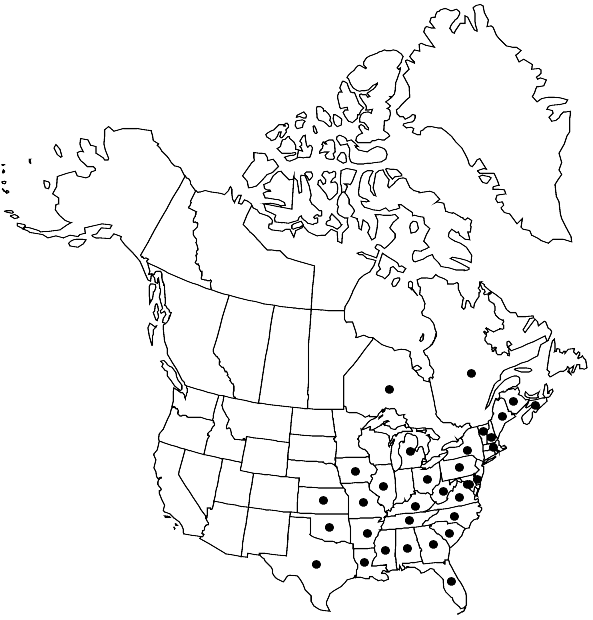Fissidens bushii
Bot. Gaz. 37: 365. 1904,.
Plants to 13 × 2–2.5 mm. Stem branched; axillary hyaline nodules weak; central strand weak. Leaves as many as 20 pairs, oblong to lanceolate, obtuse-apiculate to acute-apiculate, to 2 × 0.5 mm; dorsal lamina rounded proximally, ending at insertion, not decurrent; vaginant laminae ± 2/3 leaf length, ± equal, minor lamina ending on or near margin; margin crenulate-serrulate, more strongly serrulate on vaginant laminae; costa ending 1–2 cells before apex or ending in apiculus, taxifolius-type; laminal cells irregularly 2-stratose in dorsal and ventral laminae, smooth, bulging, firm-walled, rounded-hexagonal, 7–9 µm, papillose in cell corners with 2–4 ± inconspicuous papillae in vaginant laminae. Sexual condition dioicous; perigonia and perichaetia gemmiform, axillary, confined to proximal parts of stems. Sporophytes 1 per perichaetium. Seta to 10 mm. Capsule theca to 1 mm, erect, ± arcuate, bilaterally symmetric, about 1 mm; peristome taxifolius-type; operculum 1 mm. Calyptra cucullate, smooth, 0.6 mm. Spores 14–18 µm.
Habitat: Usually on bare or disturbed clayey soil in open and in woods, along paths, roadside banks, along streams, ravines, infrequently on rocks, stones, tree bases
Distribution

N.B., N.S., Ont., Que., Ala., Ark., Del., D.C., Fla., Ga., Ill., Iowa, Kans., Ky., La., Maine, Md., Mass., Mich., Miss., Mo., N.H., N.Y., N.C., Ohio, Okla., Pa., S.C., Tenn., Tex., Vt., Va., W.Va.
Discussion
Fissidens bushii, named in honor of the collector of the type, Benjamin Franklin Bush, is most apt to be confused with F. taxifolius. However, plants of F. bushii are usually much smaller, costa shorter, and leaves sometimes caducous. Moreover, small papillae restricted to the corners of cells in vaginant laminae are distinctive. The species is probably most closely related to the Asiatic F. teysmannianus Dozy & Molkenboer, which also has inconspicuous papillae in the corners of vaginant laminal cells.
Selected References
None.